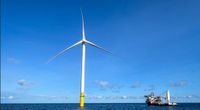On August 22, 2025, the Trump administration delivered a jolt to the renewable energy sector by ordering an immediate halt to construction on Revolution Wind, the only offshore wind project in Connecticut and the first large-scale project of its kind for Rhode Island. The abrupt move, communicated late Friday through a letter from the U.S. Department of the Interior’s Bureau of Ocean Energy Management (BOEM), left the project’s developers, Ørsted and its partners, scrambling to comply while evaluating their next steps—including the possibility of legal action.
Revolution Wind, already 80% complete according to Ørsted, was set to generate over 700 megawatts of power—305 megawatts for Connecticut and 400 for Rhode Island. That’s enough to light up about 350,000 homes across both states. With all offshore foundations in place and 45 of the planned 65 turbines already installed off Block Island’s coastline, the project was well on its way to a planned commercial operation date in the second half of 2026.
The stop-work order cited national security concerns as the driving force behind the decision. In the letter to Ørsted, BOEM’s acting director Matthew Giacona stated, “In particular, BOEM is seeking to address concerns related to the protection of national security interests of the United States and prevention of interference with reasonable uses of exclusive economic zone, the high seas, and the territorial seas.” This action follows a January 20, 2025 memorandum from President Donald Trump, which indefinitely paused federal reviews of offshore wind projects. The memo has been used as the basis for stalling or canceling several renewable energy initiatives since the administration took office.
The timing of the order raised eyebrows. Just two days earlier, the U.S. Commerce Department had announced an investigation into the national security effects of wind turbine imports, hinting at potential tariffs or quotas that could be imposed to “protect national security.” BOEM, however, did not elaborate on the specific security issues at play in the Revolution Wind case, leaving both the developers and the public in the dark.
Ørsted, the Danish company at the helm of the project, responded promptly, saying it was complying with the order “and is taking appropriate steps to stop offshore activities, ensuring the safety of workers and the environment.” The company added, “Ørsted is evaluating the potential financial implications of this development, considering a range of scenarios, including legal proceedings.” The financial hit could be significant; earlier in August, Ørsted announced it needed $9.4 billion from shareholders to help finance another offshore wind project off the New York coastline, citing “hostility” from the Trump administration as a major headwind.
The economic impact of the halt is already being felt in New England. Revolution Wind has created about 1,200 direct jobs in Connecticut and Rhode Island, with between 80 and 120 people working at New London’s State Pier at any given time. Connecticut Congressman Joe Courtney, whose district includes the State Pier, warned that about 200 jobs are at risk due to the federal stop order. “That exhaustive review ensured that transit by Coast Guard vessels and U.S. Navy warships would not be hindered by the final placement of Revolution Wind towers,” Courtney emphasized, referencing a 2023 BOEM review that had already addressed national security considerations in coordination with the Department of Defense.
Connecticut’s top officials wasted no time voicing their opposition. Attorney General William Tong declared, “We are evaluating all legal options to protect Connecticut’s interests.” He didn’t mince words about the administration’s motives: “Trump wants to mothball billions of dollars in investment and cancel one of the best new sources of American-made, renewable energy. Trump and his enablers will own the resulting cost increases for ratepayers.” Governor Ned Lamont echoed this criticism, calling the move “a political one” that would “drive up the cost of electricity bills and contradicts everything the administration has told us.” Lamont added, “We are working closely with Rhode Island to save this project, because it represents exactly the kind of investment that reduces energy costs, strengthens regional production, and builds a more secure energy future, the very goals President Trump claims to support but undermines with this decision.”
Rhode Island’s leaders were equally blunt. Governor Dan McKee described the stop-work order as undermining “efforts to expand our energy supply, lower costs for families and businesses, and strengthen regional reliability.” He highlighted the risk to “hundreds of union jobs” and the project’s critical importance for energy security and affordability. Rhode Island Attorney General Peter Neronha was even more pointed, saying the halt “can only be characterized as bizarre,” and warning that the state’s net-zero emissions goal by 2050 was “dead in the water” without Revolution Wind.
Rhode Island’s congressional delegation joined the chorus, calling the order “unwarranted and unacceptable.” The Conservation Law Foundation’s Kate Sinding Daly said the move “contravenes all common sense,” and Kit Kennedy of the Natural Resources Defense Council called it “a devastating attack on workers, on electricity customers, and on the investment climate in the U.S.” According to Kennedy, “This administration has it exactly backwards. It’s trying to prop up clunky, polluting coal plants while doing all it can to halt the fastest growing energy sources of the future – solar and wind power.”
The fishing community, too, has been drawn into the fray. On August 20, a Rhode Island nonprofit representing local fishermen petitioned federal regulators to suspend work on Revolution Wind and two other offshore wind farms, citing safety and environmental concerns. The Rhode Island Coastal Resources Management Council, which has approved every offshore wind project to date—including Revolution Wind—has sought to set up protections and compensation for fishermen, reflecting the ongoing tension between the fishing industry and wind developers.
This is not the first time the Trump administration has intervened in offshore wind. The Empire Wind project off New York was halted in April 2025, only to resume after a month. That episode, widely seen as a pressure tactic, cost developer Equinor nearly $1 billion. For Revolution Wind, the stakes are similarly high. Connecticut previously canceled another offshore wind project, Park City Wind, due to inflation and other challenges, and the state’s Department of Energy and Environmental Protection has since opted to forgo new projects in the last offshore wind solicitation.
Commissioner Katie Dykes of the Connecticut Department of Energy and Environmental Protection called the stop-work order “deeply disappointing,” adding, “Losing this much capacity means higher costs and less reliability for families and businesses in Connecticut and across New England, at a time when we urgently need more affordable, domestically produced energy to strengthen our regional grid.”
With the future of Revolution Wind hanging in the balance, the fight over America’s renewable energy direction is far from over. For now, the turbines off Block Island stand silent—a symbol of both the promise and the precariousness of the nation’s transition to clean energy.

